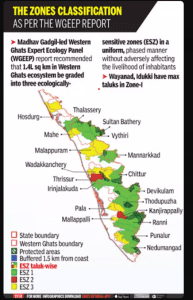THE CONTEXT: The serene hills of Meppadi in Kerala’s Wayanad district were transformed into a scene of devastation on the early morning of July 30, 2024, as catastrophic landslides buried entire villages, claiming hundreds of lives and leaving many missing. This tragedy highlights the stark socio-economic disparities in India and underscores the urgent need for sustainable land management practices.

THE ISSUES:
- Environmental Degradation and Land Mismanagement: The replacement of natural vegetation with exotic species like eucalyptus and the leveling of land for tea plantations have contributed to the instability of the terrain, leading to landslides. This highlights the ecological consequences of altering natural landscapes for commercial purposes.
- Historical Context of Land Use: The British colonial policies, which prioritized commercial interests over local practices, led to the conversion of forests into plantations. This historical exploitation has had long-lasting impacts on the environment and local communities, including the displacement of traditional practices like shifting cultivation.
- Socioeconomic Disparities: The tragedy underscores the divide between the affluent and the marginalized. Tea estate laborers who live in vulnerable areas like gorges are disproportionately affected by such disasters. This reflects broader issues of inequality, where the poor are often forced to inhabit risk-prone areas.
- Inadequate Implementation of Environmental Guidelines: The Western Ghats Ecology Expert Panel (WGEEP) had proposed guidelines to manage ecological sensitivity, but these have not been implemented effectively. This negligence has exacerbated the region’s frequency and intensity of natural disasters.
- Need for Decentralized Decision-Making: Local governance bodies like gram sabhas must be empowered to make land use and environmental management decisions. This bottom-up approach is seen as crucial for sustainable development and disaster prevention.
- Governmental Apathy and Delay: The WGEEP’s recommendations are being significantly delayed, which has led to repeated environmental disasters. The government’s lack of proactive measures to protect natural resources and empower local communities is a critical issue that needs urgent attention.
THE WAY FORWARD:
- Implement Ecological Sensitivity Zoning: The Western Ghats Ecology Expert Panel (WGEEP), led by Madhav Gadgil, recommended that the entire Western Ghats be classified into Ecologically Sensitive Areas (ESA) 1, 2, and 3, with ESA-1 being of high priority where almost all developmental activities are restricted. The Kasturirangan Committee later suggested bringing 37% of the Western Ghats under ESA, down from the 64% recommended by the Gadgil Committee. The recent notification by the government designating 56,825 square km of the Western Ghats as an ecologically sensitive area aims to regulate activities that could harm the ecosystem.
- Strengthen Land Use Planning and Building Regulations: Risk-sensitive land use planning is crucial for disaster mitigation. It involves zoning regulations prohibiting construction in high-risk areas, such as steep slopes and near drainage ways. The UNDP has emphasized that 75% of the world’s population lives in regions affected by natural disasters, highlighting the need for strategic land use planning to mitigate risks.
- Enhance Early Warning Systems and Community Awareness: The National Landslide Risk Management Strategy outlines the importance of early warning systems and community education to reduce disaster impact. Community-based disaster preparedness programs have been successful in countries like Japan, where regular drills and public awareness campaigns have significantly reduced casualties during earthquakes and tsunamis.
- Promote Afforestation and Sustainable Agriculture: Deforestation for agriculture and development has increased landslide risks in the Western Ghats. Afforestation with native species can help stabilize soil and reduce erosion. The “Green India Mission” aims to increase forest cover and restore degraded lands, which can serve as a model for afforestation efforts in vulnerable regions like the Western Ghats.
- Empower Local Governance and Community Participation: The WGEEP report advocates for a bottom-up approach to environmental governance, starting with gram sabhas and mohalla sabhas, to ensure local communities are involved in decision-making. Kerala’s People’s Planning Campaign in the 1990s successfully involved local communities in planning and development, demonstrating the effectiveness of decentralized governance in addressing local needs and challenges.
THE CONCLUSION:
The landslides in Wayanad are a grim reminder of the consequences of neglecting ecological and community-centric development. To prevent further environmental disasters and empower local communities in decision-making processes, it is imperative to heed the recommendations of the Western Ghats Ecology Expert Panel.
UPSC PAST YEAR QUESTIONS:
Q.1 Disaster preparedness is the first step in any disaster management process. Explain how hazard zonation mapping will help mitigate disasters for landslides. 2019
Q.2 Vulnerability is essential for defining disaster impacts and its threat to people. How and in what ways can vulnerability to disasters be characterized? Discuss different types of vulnerability concerning disasters. 2019
Q.3 How important are vulnerability and risk assessments for pre-disaster management? As an administrator, what are key areas that you would focus on in disaster management 2013
MAINS PRACTICE QUESTION:
Q.1 Discuss the historical context of forest and land management in India during the colonial period and its impact on present-day ecological disasters. How can the recommendations of the Western Ghats Ecology Expert Panel (WGEEP) be utilized to address these challenges?
SOURCE:
https://indianexpress.com/article/opinion/columns/ayushman-bharat-india-poor-9501487/
Spread the Word
